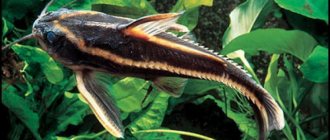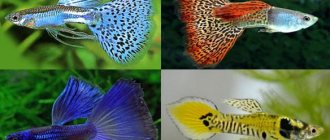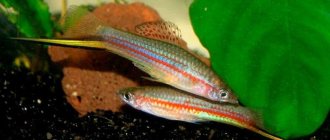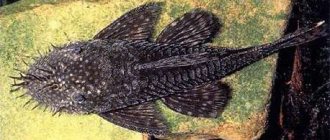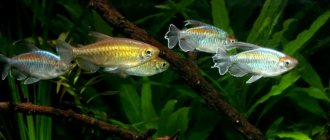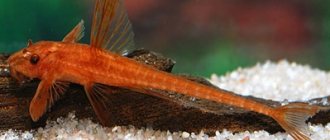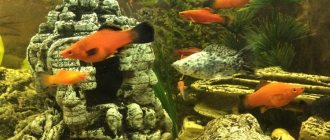The idea of starting a business in breeding African catfish is economically attractive. In Russia, many investors have successfully implemented it and are making good profits. Juicy, tender, nutritious meat without small bones is in demand in the market. To start your own business of breeding clariid catfish, you need to study the characteristics of life and reproduction of these fish.
Description and appearance
Externally, the African catfish is similar to the common species living in the rivers of Russia. The African catfish (sharmouth) has an elongated body, slightly compressed at the side. African catfish is a tasty, easy-to-grow fish that grows very quickly. The biology of fish is designed in such a way that they are able to live without water for about 48 hours, breathing ordinary air. This is evidenced by the presence of both gills and lungs.
African catfish is a strong and intelligent fish. In Africa, catfish are able to walk up to 1 kilometer when water drains from flooded rivers. From holes with water where the fish falls, it can jump up to 2 meters in height, then crawl in search of water.
The African catfish has a large, slightly constricted head and small eyes. Narrow and angular process of the occipital bone. It is characterized by a pointed, narrow clavicle with longitudinal ribs. The fish has a large and terminal mouth, above which there are 4 pairs of antennae. Has long dorsal and anal fins. The caudal fin is predominantly round. Catfish colors range from sandy yellow to gray with olive and greenish-brown markings. The belly of the sharmout is white.
Types of catfish for cultivation
The order Catfish includes almost 4,000 species. If we exclude exotic, ornamental, and fish requiring special conditions from this list, only two to three dozen species suitable for industrial cultivation will remain. The most productive among them are:
- European catfish. Large freshwater fish with smooth skin. Its back is dark, brownish-green, and its belly is almost white. The average weight of males reaches 10–25 kg, although in large rivers there are individuals 2–3 m long and weighing up to 200 kg;
- Amur catfish. Prefers fresh rivers, but is not afraid of salt water. It grows up to 6–8 kg with a length of 90–130 cm. It is distinguished by a spindle-shaped body with a dark green back and a light belly. Has a long lower fin;
- Channel catfish. The most hunted species in America. The length of the massive body reaches 110–130 cm and weighs 6–9 kg. The color of the back is from bluish-green to almost black, the belly is light. Prefers warm water and sandy bottom;
- Blue catfish. A large fish with a pale blue back and silvery belly. With a length of 60–80 cm, it reaches a weight of 5–9 kg. Lives in warm flowing waters of America, preferring a sandy or pebble bottom;
- Clary catfish. Also called African or marbled. Its elongated body reaches a weight of 8–15 kg with a length of 120 cm. It is distinguished by a light belly and a greenish back with blue streaks. Distributed in all water bodies of Africa.
Conditions of detention
African catfish is considered an unpretentious fish to keep, but still, to breed it, you have to adhere to certain conditions that are very important to observe. A fish farmer must know what water temperature is suitable for fish, what to feed the catfish and in what reservoirs to grow it.
The fish tolerates water temperatures of 18 degrees very well. The fish is able to get along in water where the temperature varies from 8 to 35 degrees. But the reproduction process is possible only at temperatures above 18 degrees, for feeding above 25 degrees.
It is not advisable to use water from lakes and rivers to fill artificial fish ponds, because with such water it is very easy to introduce an infection that the catfish will not be able to cope with. For these reasons, it is prudent to use regular well water. It is also permissible to use special installations that are designed to reduce the alkalinity of plain water.
Herd of breeders
The stock of breeders must be composed of fish that have the highest growth rate.
In females, sexual maturity occurs after 6–7 months.
The best breeding results are in females aged 1.5-2 years.
Well-developed and full-fledged gonads are formed in males after 1.5-2 years.
The breeders are kept in a separate pool at a temperature of 23 – 25 degrees Celsius.
We feed producers with well-balanced feed with a protein content of at least 35 - 38%, the daily ration is 1 - 1.5% of biomass.
There should be about 100 breeders at the fish hatchery.
Feeding regimen and rules
Breeding African catfish is not a difficult matter; besides, its nutrition does not require anything complicated from the fish farmer. The catfish is not only unpretentious to its conditions, but is also practically omnivorous.
In industrial production conditions, African catfish are fed exclusive food, the cost of which is quite high. But the advantage of such nutrition is the fastest possible weight gain of the fish.
In private plots, African catfish are fed various trash fish, including gerbil, sprat, and ruffe. It is allowed to feed them frozen fish. For young animals this food is pre-chopped. But after reaching the age of 10 days, there is no need to do this.
The daily intake of such food is 3% of the total weight of the fish. Throw fish food into a pond with catfish three times a day, distributing it over the entire surface of the pond - this promotes uniform weight gain.
Violation of the diet is unacceptable, otherwise it threatens cannibalism. With a lack of food, African catfish can begin to eat each other.
History of the species in fish farming
The first fish farms for breeding Nile catfish were formed in 1980 in Holland. After 6 years, their number reached 60, and the total output exceeded 300 tons. After another 6 years, this figure increased 4 times.
Claria Charmouths are so unpretentious and capable of absorbing any food that they instantly adapt to any conditions in which they are kept and raised. On some farms, there are up to 800 kg of live catfish per 1 cubic meter of water, and no outbreaks of infections occur.
Clarias is completely unpretentious about the quality of the reservoir, he is practically unable to get sick from anything, and gains weight very quickly.
Photo gallery of clariid catfish:
Reproduction
The technology for producing offspring of African clariid catfish under artificial conditions has been developed in some countries of the world, for example, Israel, Germany, Egypt. But the technology is under patents and has not been published in detail in the public domain.
In the CIS countries this technology has not yet been fully developed. Accordingly, all planting material is brought from foreign countries, which is why the cost of commercial products increases by 15%. Today, one African catfish fry weighing 10 grams costs 50 cents or 1 Belarusian ruble on the market.
Broodstock
Producers of African catfish are raised separately from commercial young stock. To form a broodstock, the best fish are selected, after which they create the most comfortable living conditions for them and feed them well.
Clarid catfish are capable of spawning every month if the queens are stimulated. The eggs obtained from the queens are artificially fertilized with male sperm and then placed in aquarium-type incubators. After the fry have grown a little, they are transferred from the incubator to the pools. This technology for breeding sharmut is typical for large fish farms.
Obtaining fertilized eggs when breeding catfish on a personal plot is a troublesome task. Because of this, many summer residents who raise African catfish simply buy caviar from fish farms.
When does spawning occur?
Successful maturation of eggs will ensure that the females are kept in water with a temperature of at least 25 degrees until spawning. Ovulation completely takes place 12 hours after the injection of the pituitary gland. African catfish are called nervous fish, which is why fish farmers have to euthanize females to obtain eggs without problems. An anesthetic drug is injected into the fish, most often “Propiscin”.
The eggs are obtained separately from each female. The norm is when the mass of caviar is at least 20% of the weight of a particular fish. After the procedure, females are placed in a KMnO4 solution for 1 hour. The drug is diluted at the rate of 0.5 grams per 100 liters of water.
Receiving fertilized eggs
After receiving the eggs, the fish farmer divides them into three parts, without mixing the eggs of different females. The weight of each serving reaches about 300 grams. Next, take 3 ml of milk. Efficiency will be higher when taking milk from different males - this helps stimulate the fertilization process. So, it is advisable to take 1 ml of milk from three males. Milk and caviar are dipped into water and mixed well for 5 minutes.
Growing stages
The first stage is 20-25 days. It occurs when the African catfish begins to breathe atmospheric air. During this period, about 100 individual larvae are planted per 1 liter of water. The water is gradually saturated with oxygen, which helps to establish exchange in the pool.
The larvae's diet at this moment consists of tubifex or decapsulated brine shrimp. After 7 days, starter feed is gradually introduced into the diet. They adhere to lighting requirements - it should be dim or twilight. Due to the fact that the larvae are prone to cannibalism, at the end of the first stage, out of 100 neglected individuals, about 25-50 catfish fry will survive.
Sorting of future fish is carried out in the third week. Interfering with personal space can cause fish to become stressed, so sorting fish needs to be done very carefully. Next, the fish are left in the antibiotic solution for 1 hour.
The second stage is 35 days. Initially, the fish farmer fills the pool with sorted larvae, the number of which is about 300-500 mg. Sorting of larvae is carried out by dividing them into two parts: small and larger. Catfish fry are added taking into account the individual weight of the fish and the volume of the pool. The fry must be fed three times a day, the amount of food is about 5% of the weight of the fish.
The third stage lasts several months. During this period, the weight of the fish is 130-200 grams. The growth rate of the fry depends on the stocking density. For a pool with a volume of 5,000 liters, the planting density is 2.5 pieces per 1 liter. The water temperature should be about 27 degrees. At this stage, the fry are given “floating” food. The feeding process is carried out manually or automatically. The water is changed every two hours.
Nutrition rules
A full menu affects the weight gain and immunity of individuals, so you need to know what to feed the clarium catfish. To properly create a diet, it is important to determine the age and size of the specimens.
The following raw materials are used:
- ready-made mixtures from the store;
- tripe;
- fish.
African catfish fry need to be fed up to 10 times a day to quickly gain weight.
Larvae feed on zooplankton from birth until several days. In the second week of life, they switch to compound feed in the form of a paste. For children over 100 mg, professional cereals will be the main menu item. During the day, food is given at least ten times, and the norm is 10% of the weight.
As soon as the fry reach one gram, ground spleen and ready-made food are added to the diet. The amount of food supplied is reduced to 8. After 1.5 months, the young animals gain 20 grams, after which the frequency of feedings is reduced to 5.
From the age of two years, Sharmuts are fed 2-3 times a day. The mixtures include fish waste, thawed carcasses and combined trout feed. Every day, each individual is required to consume at least four percent of its own body weight in food. It is worth remembering that when hungry they do not disdain cannibalism. During the spawning period, females are given an enhanced diet.
Productivity indicators
When African catfish are 6 months old, they are ready to be caught for further sale. Already during this period, the marketable weight of fish is about 1 kilogram. The productivity of clariid catfish is related to the quantity and quality of food.
African catfish is considered a fish that strictly gains weight according to plan, due to which a businessman can independently calculate how much weight the fish will gain when fed a certain amount of food. Accordingly, it is also possible to calculate the percentage of expected profit.
Bibliography
- Ostroumova I.N. About the protein needs of fish and its characteristics in larvae in connection with the stages of development of the digestive system. – Sat. scientific Proceedings of GosNIORH, 2005, issue 333: 207-250.
- Verreth J. van Tongeren M. Weaning Time in Clarias gariepinus (Burchell, 1822) Larvae.//Aquaculture/ - 1989. - V.83/ - P.81-88.
- Mikodina E.V., Shirokova E.N. Biological basis and biotechnology of aquaculture of African catfish Clarias gariepinus (Burchell, 1822). – Fishery. Series Aquaculture: Review information / M., VNIERKH, 1997; Issue 2.
Diseases and control
African catfish are prone to various parasitic, fungal and bacterial diseases. Some of the most important pathogens are presented in the table:
| Disease | Type | Symptoms | Treatment |
| Gill and external parasites (Trichodina maritinkae) | protozoa | White spots appear on the skin and gills. Pisces become irritable, unstable, their activity decreases, and their appetite disappears. The gills turn pale and become very swollen. | To combat parasites, baths with salt or formalin are prepared for fish. |
| Parasites (Cysticerca sp.) | nematodes | The worm affects the mucous membrane and internal organs. Usually predominates in water bodies. The fish show no visible signs of being affected by this parasite. | There are no methods to combat the parasite. |
| Parasites (Gagtylogyrus sp.) (Gyrodactilus sp.) | trematodes | The fish is located on the surface of the water in a vertical position or nervously twitches its head and body at the bottom. A thin whitish-gray mucus appears on the skin. Massive pestilence cannot be ruled out. | Eliminate symptoms with Formalin 25-50 mg/l, Dipterex 0.25 mg/l. |
| Parasites (Henneguya sp.) | protozoa | Juvenile African hybrid catfish experience white spots on their gills and skin. | Antibiotics added to the feed help eliminate the problem. Use Oxytetracycline, Terramycin or Chloramphenicol. |
| Parasites (Costia sp., Chilodonella, Trichodina | protozoa | The same symptoms are observed as with trematode infection. | Eliminate symptoms with Formalin 25-50 mg/l, Dipterex 0.25 mg/l. |
| Water mold | Gray or white tufts resembling fur appear on the fins, gills, skin and eyes. Caviar suffers from water mold. Usually the infection spreads quickly throughout the body and gills. | To treat infected fish, place them in baths with malachite green (5 mg/l for an hour) or sodium chloride (5% for 1-2 minutes). It is required that the fish are not exposed to stress and mechanical damage. | |
| Septecymia by mobile aeromonas (Aeromans sp.) | bacterium | Fish bulge their eyes, their abdomen stretches, and deep bleeding ulcers with inflammation appear on the skin. | The fish are protected from stress by using feed mixed with trimetroprim and bactrim for 10 days. |
| White bud disease (Myxobacteria) | bacterium | The fish swims near the surface of the water, positioned vertically. Swims sluggishly, not active. White spots appear on the skin near the mouth and gills. | To combat the bacteria, antibiotics are added to the feed: Oxytetracycline, Terramycin or Chloramphenicol. |
| Aeromonas septimcemia (Aeromonas hydrophila) | bacterium | The fins of catfish turn red and ruffle. The fish lose their bright colors. Ulcers appear on the skin. | Oxytetracycline, Sulfamethoxine, and Ormethoprim are added to the food. |
| Head deformation | The skeleton is deformed, the fish loses its appetite, it becomes lethargic and dies with swollen tissue on both sides of the head. This problem usually occurs in fish whose length is less than 10 centimeters. Dead fish have a thickened and curved skull, which indicates that cracks have formed. | To prevent individuals from experiencing head deformation, vitamin C is regularly added to their food. | |
| Bowel injury syndrome | The abdomen swells, the color on the ventral side is darker, and the anal area takes on a reddish tint. At the final stage, the abdominal wall is damaged. Fish exhibit lethargic behavior. | Balanced and well-digestible food will help solve the problem. | |
| Peptic ulcer | When infected, African catfish become covered with red or white ulcers on the skin of the lower and upper jaws, and on the surface of the caudal fin. The behavior of the fish becomes sluggish. | To prevent peptic ulcers, fish farmers need to monitor the quality of water and remember to change it regularly. |
Is it possible to make money by breeding African clary catfish?
Beginning entrepreneurs use extensive or semi-intensive cultivation methods, while businessmen with good start-up capital prefer the intensive method.
A business plan for organizing a business is based on the calculation of expected costs and annual profits. You will need to invest in the construction of a small reservoir with the necessary ecosystem.
You cannot do without installing auxiliary equipment, including filters and lighting systems. You will need to not only obtain the required permits, but also calculate the costs of purchasing feed and fry, and establish relationships with the supplier. Also, to promote the business, it would not hurt for an entrepreneur to attract customers by advertising.
Premises requirements
For catfish breeding, it is recommended to use a large area; this will allow you to quickly cover costs and start making a profit. To produce 100 tons of fish per year, choose an area of at least 0.06 hectares. To create comfortable conditions for fish, the water in the tanks must be changed regularly, and powerful filters are installed in the pools.
Basic expenses
Before assessing the real profit from the African catfish breeding business, the main expense items are considered, including the construction of a pond, the cost of which will cost 50-100 thousand rubles. It will be necessary to install heating, filtration, ventilation and lighting systems, which will cost about 300 thousand rubles.
What else will you have to spend on:
- Buying caviar or fry. More often, preference is given to catfish fry, the cost of which for 5 thousand individuals is up to 1,500 rubles.
- Fish food. For extra-class food, an entrepreneur will have to pay about 150 rubles per 100 kilos. The same amount of premium food will cost about 250 rubles. At the same time, the cost of a kilogram of marketable fish is about 150 rubles for wholesale sales.
- Equipment and workwear. This will cost about 60 thousand rubles.
Total expenses can amount to half a million or more rubles. However, it may take a year or more to cover the investment and make a profit.
Documentation
In order for your business to be legitimate and legal, you must prepare a package of papers at the planning stage. This includes:
- registration of an individual entrepreneur, for which a passport, application, receipt of payment of state duty and TIN are submitted to the tax office;
- selection of OKVED code – 2.03 – fishing and fish farming;
- the taxation system can be a single one imputed to income;
- permits from local governments and the State Committee for Water Resources;
- conclusion of the sanitary and epidemiological station.
Please note that with small volumes of fish grown and sold, it does not make sense to create a legal entity (LLC). After all, then you will have to maintain complex documentation, pay additional taxes, waste time and money on unnecessary permits and certificates. But withdrawing profits will be more difficult.
Here you can download a free sample business plan for catfish farming.
Home breeding
Growing African clariid catfish at home involves several methods:
- Breeding in the pool. The fish are grown within a certain limited water space, that is, they are placed in a pool located on the territory of a summer cottage. Preparing the area and purchasing equipment costs a large sum, and there is also no need to create climatic conditions - a closed water supply system, the presence of heated water. This option is ideal for fish farming in cold areas.
- Cage cultivation. The method involves keeping fish in specialized cages, where fry and adults are kept separately. In closed conditions, it is possible that adult fish will begin to eat their offspring.
- Feeding breeding. When choosing this option, African catfish are kept together with other species of fish, but of similar sizes, in order to eliminate the likelihood of aggression and attacks.
- Pond cultivation. In the summer, young animals are released into the pond on personal plots. It's easy to prepare for this method, but the growing process itself can lead to some risks. Pond breeding of catfish is suitable only for the southern and warm regions of the country.
Catfish can be raised extensively, because it does not require large investments in the construction and arrangement of a pond. This way the fish will have access to natural food found in the water. When growing in cages, the entrepreneur will have to purchase food and special structures for arrangement.
Many recommend raising catfish using an intensive method - the fish are created with the most favorable conditions: the optimal temperature is set for weight gain, a feeding regime is established, etc.
It is acceptable to use catfish as a “nurse” in a pond when it is raised with other types of fish. But due to the fact that the clary catfish is a predatory fish, carp or trout of the same size are carefully selected for joint breeding so that the catfish does not eat them.
Home breeding of African catfish involves releasing the fry into a pond at a water temperature of 15 degrees. The most optimal temperature for fish growth is considered to be 25 degrees. There are about 60 fry per reservoir with a capacity of about 2 thousand liters.
The fish are fed at least three times a day, using ready-made feed and mixed feed. Catfish feed on plant foods, due to which, as complementary food, the fish are fed chicken giblets, various insects, and earthworms. The amount of food is calculated based on the weight and age of the individuals.
By the age of 2 years, fish reach sexual maturity, due to which they are used for breeding.
For a profitable business, it is necessary to provide the fish with an indoor pond for wintering, otherwise growth will slow down and the young may die. For winter maintenance, you cannot do without an air pump and a device that will maintain a stable temperature in the pond. A prerequisite for breeding is to ensure dim lighting.
Why raise catfish?
Catfish are a large group of freshwater fish without scales. Among them there are both huge river inhabitants weighing 400 kg and miniature aquarium species a couple of centimeters long. Breeding catfish at home as a business is primarily focused on obtaining marketable individuals weighing about 1–3 kg, suitable for consumption. The soft and juicy meat of these fish contains practically no small bones and is highly valued in cooking:
- Catfish and its fillets are prepared in all existing ways - boiled, fried in oil and in batter, stewed and baked with vegetables. Very tasty shashlik and catfish barbecue;
- Fattier tails are used as a filling for pies and rolls. They are also used to make cutlets, meatballs and chops, goulash and fish salads;
- The heads are considered an excellent basis for soups, solyanka and fish soup. No less popular are jellied and jellied catfish.
In addition to excellent taste, catfish meat is also characterized by a unique set of essential amino acids and microelements, so experts consider it very useful for the human body. In particular:
- Meat contains amino acids and vitamins that have a beneficial effect on the nervous system. In fact, it can be called a natural antidepressant;
- Riboflavin and pyridoxine, which are also included in its composition, stimulate the cardiovascular system and enhance hemoglobin synthesis;
- Due to the high concentration of trace elements and ascorbic acid, catfish meat is useful in the treatment of colds and viral diseases;
- Tender catfish meat is easily digested by the body, which allows it to be included in various therapeutic and health-improving diets;
- Fish contains a lot of phosphorus, without which the restoration of muscle and bone tissue is impaired, the functioning of the brain and nervous system as a whole deteriorates;
- Caviar and fish oil are real concentrates of fatty acids that regulate cholesterol levels and prevent atherosclerosis.
Main problems with cultivation and breeding
African clary catfish are farmed by private individuals using systems that meet environmental standards. In traditional floodplain ponds, farmers have had to fine-tune sustainable fish farming practices for decades. Their self-organization within local communities was dictated by customs and recommendations of non-governmental structures in order to preserve fishing grounds.
Due to the recent collapse of the African Clary Catfish market in South Africa, reducing production costs, including remaining competitive, has become particularly important. This makes it possible to improve the ecosystem of ponds, rather than maintaining systems of increasingly intensive cultivation and improving feeding technologies.
African catfish are especially valued for their interesting appearance, increased resistance to diseases, unpretentiousness to living conditions and omnivorousness. Today, many fish farmers who have correctly drawn up a business plan, taking into account costs and possible profits, are engaged in breeding this fish.
1
0
Copy link
Business Features
Until recently, catfish remained in the shadow of more popular aquaculture species - carp, trout, silver carp and grass carp.
The reason for this was the heat-loving nature of this type of fish: for active feeding and growth, it needs water with a temperature of 24–27°C, which is hardly achievable in open waters of most regions of Russia. But with the advent of inexpensive and compact closed water supply systems on the market, it was discovered that in comfortable conditions with intensive feeding, catfish are several times more productive than other aquatic inhabitants. According to reviews from experienced entrepreneurs, the most profitable in this line of business is breeding African clariid catfish. Its advantages compared to other types of fish impress even specialists:
- Clariuses are extremely efficient at digesting food. To obtain a weight gain of 1 kg, you need to consume only 800–900 g of feed;
- The fish grows incredibly quickly, gaining 3-5 g of weight per day. Therefore, keeping catfish is more profitable than breeding crucian carp in a pond at the dacha;
- The method of growing catfish is well known. The ideal composition and temperature of water, feed recipes, and incubation parameters were experimentally found;
- The fish tolerates high stocking densities comfortably. From a cubic meter of pool you can collect 500 kg of catfish, but in a business such as sterlet breeding - only 50 kg;
- Like many other species of catfish, clarius are not afraid of a lack of oxygen, since they can swallow atmospheric air. Therefore, they do not die when the system fails;
- Catfish calmly tolerates water pollution, which, for example, when breeding shrimp at home, causes immediate death of the herd;
- The meat of clariid catfish does not have the muddy smell characteristic of river fish, so cooks and housewives prefer it to other similar products.


